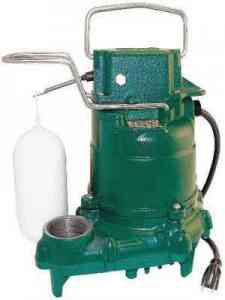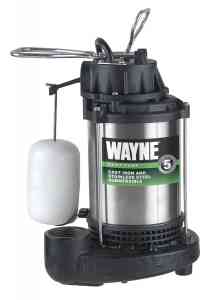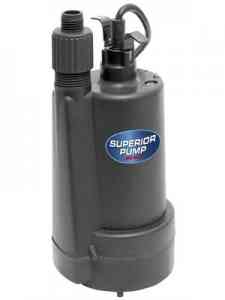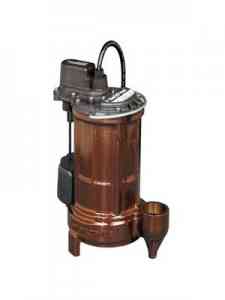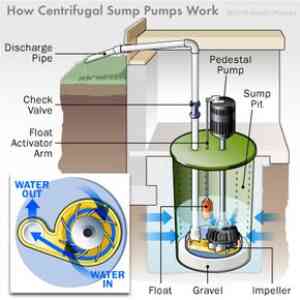The Best Sump Pump In 2024 (Top Picks)
The risk when your home is at a lower level than some other homes (below the water table) is that it’s more susceptible to flooding.
While the house or bottom-floor apartment might seem like it’s safe, we all have seen a noticeable increase in flash flooding and rivers overflowing their banks in recent years with the effects of global warming.
Rising sea levels and more erratic weather patterns are evident and this is leading to areas of the country that see more frequent floods than in decades past.
To prevent a complete loss in the basement of all possessions there, along with electrical wiring issues, building structural problems, mold, and other concerns caused by rising dampness, it’s sensible to consider putting in the best sump pump.
These are designed with sensors that trigger the engine to kick off and start pumping water out of the basement once it’s reached a level that initiates the machine.
Look at the top 5 Best Sump Pumps
Most Compact –Zoeller M53 Mighty-Mate
Best Choice – WAYNE CDU980E 3/4 HP
To Rated – Basement Watchdog BW1050
Best Value –Superior Pump 91250
Most Versatile – Liberty Pumps 257 1/3 HP
Leading Sump Pump List
There are different types of sump pump systems, so we cover those in the next section followed by the reviews of the top sump pumps available after that.
[wpsm_titlebox title=”1″ style=”3″]Zoeller M53 Mighty-Mate Submersible Sump Pump, 1/3 Hp
The Zoeller M53 might look small but it’s the little pump that could. What sets it apart initially from a crowded field of capable sump pumps and effluent pumps too is its casing. The casing is made from cast iron despite its green exterior appearance.
This provides far more durability from moisture and rust along with general wear and tear compared to a plastic-based sump pump that can crack or deteriorate in much less time. As such, even a ground-shaking is unlikely to cause accidental damage to this unit whereas one with a plastic case might sustain a crack along its seam, by comparison.
In terms of the engine, it packs a punch too. It brings along a 1/3 horsepower efficiency that’s impressive for its size. This delivers a flow rate of 2,580 GPH (gallons per hour) when fully powered and pumping water and solids.
The flow rate will drop lower when pumping water and waste uphill depending on the incline level. It pushes the engine much harder to do so and subsequently, the flow rate is far lower in that situation. Therefore, the flow rate is subjective to the situation, as is the case here.
For any basement that’s flooding quickly, the flow rate is very important because any pump must be able to not get clogged up while pumping out water quicker than it’s coming into the basement. This prevents the flood water level from rising any higher.
Speaking of solids, up to solids of 1/2-inch can pass through the unit without their causing a clog. This is useful given that not all wastewater or flood water is pure and clean picking up dirt, soil, and other detritus along its path which can flow right into available basements.
The detection system is powered by the float which has a switch that triggers the engine to power up should the float rise with the water level. It’s a simple mechanism that doesn’t rely on fancy or finickity electronic systems that can fail you.
[wpsm_column size=”one-half”][wpsm_pros title=”PROS:”]- A sump pump that works in a basement
- 1/3 horsepower motor
- Also suitable for septic tanks and other purposes as well
- Can push many gallons uphill per hour (incline dependent)
- Float switch that triggers engine activation
- Handles solid matter up to ½-inch
- Cast-iron housing with better durability than plastic
- Plastic underside
- The float switch is a bit temperamental
- Only 1/3 horsepower; depending on the speed of flood water whether that’s enough
[wpsm_titlebox title=”2″ style=”3″]
WAYNE CDU980E 3/4 HP Submersible Sump Pump
The Wayne CDU980W benefits from a reliable, trusted brand. The parts are supplied often both from abroad and in the States, while each unit is assembled Stateside and tested to ensure it’s up to the Wayne quality standard.
The three-quarter horsepower sump pump is designed with both stainless-steel housing and a cast-iron base along with hardened plastic to provide the right type of resilience to water over time. Subsequently, the unit isn’t too heavy to lift into position.
It’s designed ideally to go directly inside a sump pit to capture floodwater falling into it and moisture from the soil around it that’s drenched from nearby water sources below the surface which could affect the foundation of the house.
The suction system is purposely put together to prevent air locks from causing the unit to stop pumping. Clogs from debris in the water is also avoided through clever design. Much like with the model previewed above, the float switch hangs vertically which rises with the incoming water as the water rises in the basement. This in turn activates the engine to start pumping the water out.
The water flow is 4,600 GPH using the full ¾ of a full horsepower when moving water up 10- feet from its original position. When propelling water upwards by 20 feet, then the flow rate drops to 3,500 GPH.
This tapers down depending on how far water needs to be pushed upwards. Up to 1,000 cycles for triggering pump activation using the switch have been tested with this model design.
This sump pump is expected to provide a longer service as demonstrated by the high-quality materials and testing involved in the product line. There’s a five-year warranty included with this product from Wayne.
[wpsm_column size=”one-half”][wpsm_pros title=”PROS:”]- ¾ horsepower sump pump
- Ideal for a sump pump pit
- Uses cast iron and stainless steel in its construction
- Up to 4,600 GPH which drops to the three-thousands when putting on a 10-feet incline
- Costs more but won’t need to replace the sump pump as often
- Self-priming switch which activates when the water level reaches the right point
- Can be installed by someone good at DIY
- 7.5-feet power cord which connects to the pump around 11 inches above the bottom
- 5-year warranty
- Costlier compared to less long-lasting models
- There might be more sump pumps than some homeowners feel they need
- The float switch must be properly aligned, or it won’t trigger the engine to turn on
[wpsm_titlebox title=”3″ style=”3″]
Basement Watchdog BW1050 Portable Sump Pump

The Basement Watchdog and their BW1050 model is an upgrade from their 2,200 GPH model (this one will push out 2,820 gallons per hour). The flow rate isn’t going to match one of the more powerful Wayne sump pumps, but it depends on what you feel you need.
Are local basement floods minor events or does the whole basement fill up quickly with several feet of water and then you’re stuck? The 10-foot power cord is a generous length. The unit can handle up to 40-centigrade or 104-frenheit warmth, so even a flash flood in the heart of summer won’t be a problem. Fitting this pump into a narrower (try 7 inches wide!) than normal sump pit is possible which is a major selling point here.
The split capacitor motor that drives the lower GPH is efficient enough to run well. Clearing debris is the real issue here though. This model doesn’t have great capabilities when it comes to handling solid materials, unlike some other models under review. As a result, it can get jammed up if some wrong-sized debris comes along to do so.
At this point, the water flow stops while the engine still drives the pump eventually likely causing it to burn out. As a result, you end up needing to be the watchdog for this Basement Watchdog model and not the other way around. The model comes with a three-year warranty. However, should it fail to clear the basement in a flood because partway through the process, the pump got blocked, then a replacement comes too little, too late.
[wpsm_column size=”one-half”][wpsm_pros title=”PROS:”]- Narrow sump pump that fits into 7-inch wide sump pits when other models won’t fit
- Continuous operation design
- 10-feet power cable
- Float switch to activate motor
- Provides 2-4 years of use
- Aluminum housing can deteriorate and develop holes in wet conditions over a few years
- Expect to need to replace every few years
- Lower GPH than other pump models
- Can get more easily clogged by debris and the motor can burn out as a result
- Louder than rivals
[wpsm_titlebox title=”4″ style=”3″]
Superior Pump 91250 1/4 HP Thermoplastic Submersible Utility Pump
The Superior Pump 91250 model is marketed as a utility pump rather than a sump pump but it’s a flexible and powerful product that has multiple uses. It can be used as a standing pump but also to drain water from a tankless water heater.
Customers have put this model through a variety of uses including removing water from a pool too. It is made from thermoplastic and comes with a 10-foot cord. It is submersible, so it will go in a sump pit but equally into a pool completely submerged too. The ¼ horsepower motor comes with split capacitors to save power and uses solid copper with the motor winding and reliable seals for the motor.
There’s an intake screen that prevents large solids from getting inside. This is removable and cleanable too. The model can be lifted out using the carry handle. It will handle 1/8-inch size solids without jamming up.
There’s both a 1 ¼-inch discharge (NPT) connection and a useful ¾-inch adapter for a garden hose too. The motor is capable of shifting 1,800 GPH which falls to 540 GPH at 20 feet. It hits a maximum of around 25 feet of water movement. A 1-year warranty is included with this product.
[wpsm_column size=”one-half”][wpsm_pros title=”PROS:”]- Thermoplastic outer case
- ¼ horsepower motor with some improved features
- Both an NPT discharge connection and a garden hose adapter too
- Use in a sump pit, as a pool drainer, and for other purposes
- 10-foot power cord
- Short warranty period
- Mixed-use limiting the GPH capacity
[wpsm_titlebox title=”5″ style=”3″]
Liberty Pumps 257 1/3 HP Submersible Sump Pump
The 257 model from Liberty Pumps is a submersible pump that is both a sump pump and an effluent pump for pumping out grey water from a septic tank too if this is required. What’s noticeable right away is the cast iron color on the exterior that has an epoxy coating on it, which makes this 257 model appear different to its peers.
It has a 1/3 horsepower motor which has a single-piece cast iron housing. Coming back to the motor, it’s protected thermally yet is designed for short bursts of activity and not continuous running. It’s also not going to survive dry running with a blockage and no water flowing through the system either (which would likely cause burnout).
It will fit inside a sump pit that’s at least 1 inch in diameter. It is capable of handling ½-inch sized solids but nothing more than that without causing potential blockages. The magnetic float that hangs vertically is designed mostly for sump application.
[wpsm_column size=”one-half”][wpsm_pros title=”PROS:”]- Epoxy coating on the exterior
- Powerful 1/3 horsepower lubed motor
- Ideal for short operations to remove water quickly
- Handles ½-inch solids, no problem
- 10-foot power cord
- Vertical float using magnetism to activate
- Can damage the engine if dry-running
- Requires a 10-inch diameter or wider sump pit
- Won’t continually run without damaging the unit
- Minimal effluent usage advised
Different Types of Sump Pumps
In most cases, a standard sump pump is what is required. However, there are different types of pumps available, For pumps specifically, there are either submersible pumps or pedestal sump pumps.
The main difference is that the upright pedestal pumps are slim and tall whereas the motor sits at the peak. These are easier to access but far noisier during operation. Submersible pumps (which we reviewed in this guide) are more popular, much quieter once installed, and tend to last longer than pedestal pumps too.
This is why they’re the obvious choice in most install and real-use situations.so it’s useful to understand what the options are, in case another type is more suitable for you:
- Sump Pump
The sump pump is the main type of pump that’s used in homes. It’s designed to get triggered with a float switch mechanism that hangs near what could be a rising water level and gets triggered to turn on should a rise in the float’s position be detected (water pushes up the float’s level).
Most function based on a plastic bottle that hangs over the area which will naturally rise should the basement begin to flood. The rising of the plastic bottle moves an arm that has a switch that gets flipped when the level is high enough to do so.
The engine is then automatically triggered to start collecting water through the pump system and ejecting it through the attached pipes to the exterior of the property.
These types of pumps are quite flexible for use in different situations – like removing water from a pond – but aren’t always the most suitable pump for every purpose.
Portable pumps are usually expected to be used primarily in the basement. Sump pumps also usually powered by mains electrical power which can get cut in an electrical storm with a flood that follows leaving basements vulnerable even if they had a pump installed.
- Backup Sump Pump
A backup pump is designed to run on battery power which is regularly charged up. The idea is that it can provide sufficient power to operate a pump for a limited period if the power goes out.
It’s quite common for homeowners to purchase both a normal sump pump and a backup sump pump. This is preferable over a combination pump that aims to be an all-in-one product.
While the backup pump protects from electrical power failure where the standard pump doesn’t usually work, it is also a separate unit that can be replaced independently of a fitted pump.
- Combination Sump Pump
A combination sump pump includes both a sump pump and a battery backup in a single product. This is an alternative to purchasing and having both pump and battery backup products installed individually.
While a combination pump is useful at times for basement flooding as a single solution, there are some drawbacks. These include needing easy access to the battery area to replace the battery should it fail or die at a later time.
Most pumps are fitted inside a sump pit which is quite small. It’s inconvenient to need to gain access to this just to swap out a battery. Also, should one part of the single equipment fail, you lose both the primary pump and the backup option too.
The single point of failure issue is problematic as it leaves the home vulnerable until a fix or a fitted replacement can be obtained and installed.
- Sewage Pump
A sewage pump is one that is capable of pumping out dirty water and some solids too. It is durable with most of these types of pumps being submersible when the need arises.
This type of pump can be used to shift groundwater that isn’t moving, remove domestic water after flooding, or empty a backyard pond. It’s a flexible solution to deal with severe flooding situations, mostly after the fact.
- Grinder Pumps
A grinder pump is installed at the lowest level position either in the backyard or the house itself. The pump activates when wastewater hits a fixed level at which point, it starts to collect and pump the water towards a new destination.
These types of pumps hold enough power to propel wastewater to a higher ground level to reach where the sewers are located. This removes areas with still water that could sit there, which is bad for bacterial buildup, possible future mold, and other issues.
- Effluent Pump
Effluent pumps are designed specifically to pump out grey water which is wastewater like the type stored in RVs from their internal toilet systems. Septic tanks are usually emptied using an effluent pump when other standard systems are inoperable.
This type of pump can also deal with water from laundry and other wastewater that has some solids in it but not too much.
How To Choose The Premier Sump Pump For Basement
Now that you’ve seen our list of recommended products, it makes sense to get a better idea about sump pumps specifically. To do this, we’re providing this buyer’s guide below that covers a few of the major details worth mentioning.
- Engine Motor Differences
There’s no one-size-fits-all when it comes to engine motor sizes. You will find that they run the gamut from ¼ horsepower (HP) right up to 1 horsepower and beyond. Generally speaking, a motor with extra horsepower is capable of shifting more water. However, that doesn’t usually mean that it’s a continuous running system – most pumps are only designed to be turned on for 1-2 hours and then turned off again (or an even briefer running time).

- Water Flow Rate Vs Purpose
With the connection between horsepower and pumping ability, it’s important to consider what purpose you’ll use your sump pump for. Some are multi-use and can equally pump out a pool or pond or remove water from a tankless water heater. Others are dedicated devices that ideally is installed in a basement permanently even if they’re technically portable versions with carrying handles.
For basement flooding situations, how large is the basement? How much water could flow into it and how fast? This gives a better sense of what your requirements are. Lower horsepower motors may not keep up with requirements if a flash flood starts to fill a large basement quicker than expected, in which case the basement floods anyway. Something to consider!
- Gallons Per Hour (GPH)
Along with the horsepower rate, the gallons per hour (GPH) are mentioned in our reviews. This is an indication of the rate at which water can be pumped out of a basement. Now here, you must bear in mind that when pipes are moving the water from below ground level up to the natural ground level above, the amount of feet pumping the water higher or simply along the pipe from the pumping station will lower the stated GPH.
How Long Can a Sump Pump Be Expected to Last?
A reliable sump pump may last a decade, however, it’s important to appreciate how wet soil and moisture impact the outer casing of a pump. The material casing can easily develop holes making the pump unusable within a few short years if the pump is cheap and/or inferior.
Materials like cast iron and durable plastics can stand the test of time. Often, the casing fails before the engine or other parts do when it’s less effective.
Look at the warranty details. The pumps with better outer materials to last longer have warranties for 3 years or 5 years. The lesser ones may only provide a 1-2-year warranty, which says a lot about the product. Similarly, the pricing tends to reflect the warranty period and how long the product can be expected to last.
- Power Needs
Most pumps aren’t too power-hungry because they’re only sucking down the power when they’re activated and pumping. At other times, they use minimal power. The length of the power cord is a useful one to look at, as it must make it out of the sump pit and to an extension cord or a power outlet.
Bottom Lines
With top sump pumps, they may all look similar but they’re quite different from one another. Depending on the brand and the model, you get different expected longevity. It’s tough to handle a lot of water and moisture and dampness and stay operational.
It takes a toll on the housing which can rot away with lesser materials and the engine suffers if running while the innards are blocked up too. Pick a model that suits the ultimate purpose; a multi-use model will be okay but won’t perform brilliantly at any single task.
If you want a pump solely as a sump pump, then choosing one designed expressly for that purpose is likely going to offer better performance in this role. [/wpsm_titlebox]

